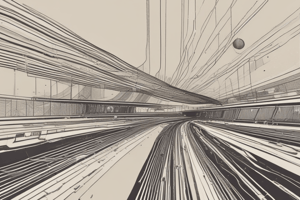Podcast
Questions and Answers
Displacement is defined as the total length of the path traveled by an object.
Displacement is defined as the total length of the path traveled by an object.
False (B)
Distance is always a negative quantity because it measures the path traveled by an object.
Distance is always a negative quantity because it measures the path traveled by an object.
False (B)
The formula for average speed is given by Average Speed = Total Distance / Total Time.
The formula for average speed is given by Average Speed = Total Distance / Total Time.
True (A)
Acceleration is the rate of change of distance with respect to time.
Acceleration is the rate of change of distance with respect to time.
In a velocity-time graph, the slope represents speed.
In a velocity-time graph, the slope represents speed.
The equation v^2 = u^2 + 2as is used for calculating the final velocity in uniformly accelerated motion.
The equation v^2 = u^2 + 2as is used for calculating the final velocity in uniformly accelerated motion.
Uniform motion indicates a variable speed while traveling in a straight line.
Uniform motion indicates a variable speed while traveling in a straight line.
The rate of change of displacement with respect to time is known as speed.
The rate of change of displacement with respect to time is known as speed.
The area under a velocity-time graph represents displacement.
The area under a velocity-time graph represents displacement.
The formula for average acceleration is given by Change in Velocity / Time Taken.
The formula for average acceleration is given by Change in Velocity / Time Taken.
Flashcards are hidden until you start studying
Study Notes
Laws of Motion: Motion In A Straight Line
- Definition: Motion in a straight line refers to the movement of an object along a linear path, where it changes its position over time.
Key Concepts:
-
Displacement:
- Definition: The shortest distance from the initial to the final position of an object, with a direction.
- Formula: Displacement (s) = Final Position (x_f) - Initial Position (x_i)
-
Distance:
- Definition: The total length of the path traveled by an object, irrespective of direction.
- Distance is always a positive scalar quantity.
-
Speed:
- Definition: The rate of change of distance with respect to time.
- Formula: Average Speed = Total Distance / Total Time
- Units: meters per second (m/s)
-
Velocity:
- Definition: The rate of change of displacement with respect to time, including direction.
- Formula: Average Velocity = Displacement / Total Time
- Units: meters per second (m/s)
-
Acceleration:
- Definition: The rate of change of velocity with respect to time.
- Formula: Average Acceleration = Change in Velocity / Time Taken
- Units: meters per second squared (m/s²)
-
Equations of Motion (for uniformly accelerated motion):
- First equation: ( v = u + at )
- Where:
- v = final velocity
- u = initial velocity
- a = acceleration
- t = time
- Where:
- Second equation: ( s = ut + \frac{1}{2} a t^2 )
- Third equation: ( v^2 = u^2 + 2as )
- First equation: ( v = u + at )
-
Graphical Representation:
- Distance-Time Graph:
- Slope represents speed.
- A straight line indicates constant speed; a curve indicates changing speed.
- Velocity-Time Graph:
- Slope represents acceleration.
- Area under the graph represents displacement.
- Distance-Time Graph:
-
Types of Motion:
- Uniform Motion: Constant speed in a straight line.
- Non-Uniform Motion: Variable speed; changes in distance over time.
-
Newton's Laws of Motion:
- First Law (Inertia): An object remains at rest or in uniform motion unless acted upon by an external force.
- Second Law (F=ma): The acceleration of an object is directly proportional to the net force acting on it and inversely proportional to its mass.
- Third Law: For every action, there is an equal and opposite reaction.
Applications:
- Analyzing vehicle motion, projectile motion, and any linear movements in physics and engineering contexts.
Motion in a Straight Line
- Defined as the movement of an object along a straight path, changing its position over time.
Key Concepts
-
Displacement
- Shortest distance between initial and final positions, includes direction.
- Calculated using the formula: Displacement (s) = Final Position (x_f) - Initial Position (x_i).
-
Distance
- Total path length traveled, regardless of direction.
- Always a positive scalar quantity.
-
Speed
- Rate at which distance changes over time.
- Average Speed calculated as Total Distance / Total Time.
- Measured in meters per second (m/s).
-
Velocity
- Rate of change of displacement over time, includes direction.
- Average Velocity calculated as Displacement / Total Time.
- Also measured in meters per second (m/s).
-
Acceleration
- Rate at which velocity changes over time.
- Average Acceleration calculated as Change in Velocity / Time Taken.
- Measured in meters per second squared (m/s²).
Equations of Motion
- First Equation: Final velocity (v) = Initial velocity (u) + (acceleration (a) × time (t)).
- Second Equation: Displacement (s) = (Initial velocity (u) × time (t)) + (1/2 × acceleration (a) × time²).
- Third Equation: ( v^2 = u^2 + 2as ).
Graphical Representation
-
Distance-Time Graph:
- Slope indicates speed; straight line shows constant speed, while curve indicates varying speed.
-
Velocity-Time Graph:
- Slope represents acceleration; area under the graph quantifies displacement.
Types of Motion
- Uniform Motion: Object maintains a constant speed in a straight line.
- Non-Uniform Motion: Speed varies, leading to changes in distance over time.
Newton's Laws of Motion
- First Law (Inertia): An object stays at rest or in uniform motion unless influenced by an external force.
- Second Law: Acceleration (a) is directly proportional to net force (F) and inversely proportional to mass (m), described by the equation F=ma.
- Third Law: For every action force, an equal and opposite reaction force occurs.
Applications
- Useful in analyzing vehicle movement, projectile motion, and any linear dynamics in physics and engineering settings.
Studying That Suits You
Use AI to generate personalized quizzes and flashcards to suit your learning preferences.




